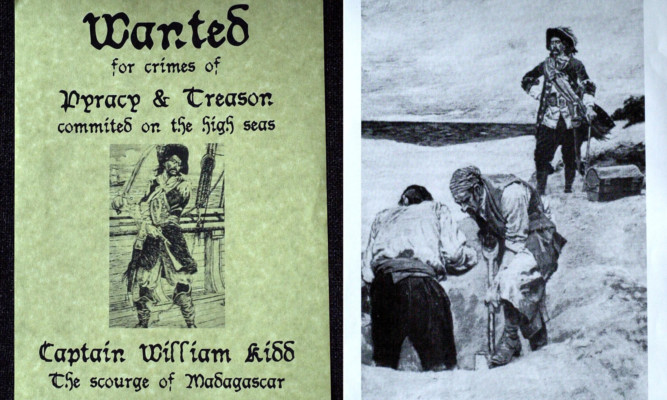He was one of the most infamous and unfortunate – pirates of all time.
Born in 17th century Dundee, Captain William Kidd was said to have amassed treasure worth £100,000 – a staggering £12 million now – before he was arrested for piracy and murder.
He buried a cache somewhere on his travels and at his trial in 1701, tried to barter his knowledge of its location in return for his life.
Kidd’s plan failed and he was sentenced to hang, his decaying body left to rot in public view for three years to deter other would-be pirates.
But the mystery of his missing loot goes on to this day, captivating adventurers who are convinced that his untold riches are still out there for the taking – if only they could find them.
Now controversial French diviner Albert Fagioli claims to have used his “extrasensory abilities” to locate the site of the long lost treasure in the South China Sea.
Ridiculed by sceptics as far-fetched, the amateur sleuth studied the infamous Kidd-Palmer charts which were discovered by retired lawyer and collector of pirate relics, Hubert Palmer, in 1929 in a number of items of furniture that were said to have belonged to Captain Kidd.
Using modern technology such as Google maps in conjunction with his own water divining equipment, Mr Fagioli, who lives in the north-east French town of Charly Oradour, claims to have pinpointed Kidd’s treasure island to the Ko Wang Nok island off the coast of Thailand.
The story goes that in 1929, wealthy retired lawyer Hubert Palmer bought a heavy 17th century oak bureau bearing the inscription ‘Captain William Kidd, Adventure Galley 1669,’
It is said that within the bureau Palmer found a secret compartment which contained a hand drawn map of an unnamed island, it bore the initials W. K., the words ‘China Sea’ and was dated 1669.
Palmer went on to track down two sea chests and a wooden box that were also supposed to have belonged to Kidd. Palmer claimed to have found further maps in all three of them, all depicting the same unknown island, but with varying levels of detail. Amid speculation as to whether the maps were fakes, their whereabouts is now thought to be unknown after they were bought by a Canadian decades ago.
Contacting The Courier from France, Mr Fagioli, 51, who recently claimed to have used his divining skills to find previously undiscovered medieval chambers beneath the French city of Carcassonne, said he had used the same methods to study these maps and others and now believed he had found the answer to the Kidd conundrum.
The father-of-one, who works as a mechanic in the beverage can industry, said: “I have discovered the treasure island of Captain William Kidd. It only took me 20 minutes to locate the island. This outstanding result is due to my extrasensory abilities and my precious dowser, in addition to a few maps of the oceans and Google Earth.
“While specifying the size of the island and its relief, I was able to find the famous treasure island sought for more than three centuries by historians from the entire world. This is a great discovery!”
Mr Fagioli believes that the Palmer-Kidd cards were deliberately made cryptic by the captain to keep treasure seekers at bay and says there is no guarantee the treasure is actually there.
Now he hopes to meet with the King of Thailand to talk about his controversial discovery and to also visit the island in the east of Khanom.
